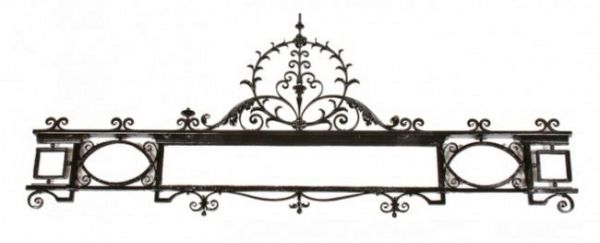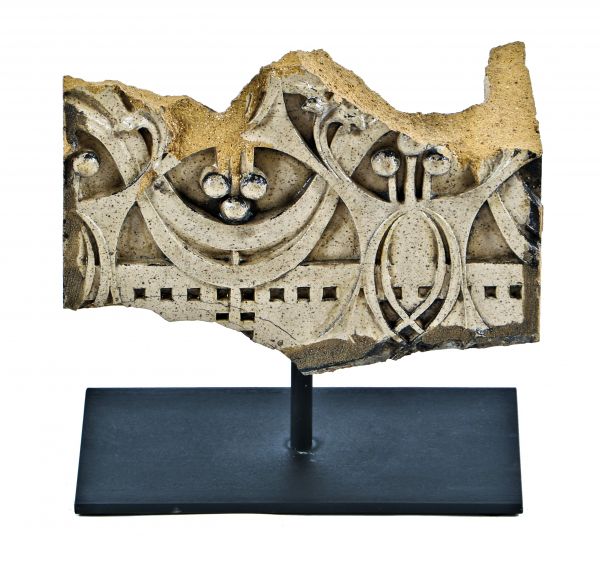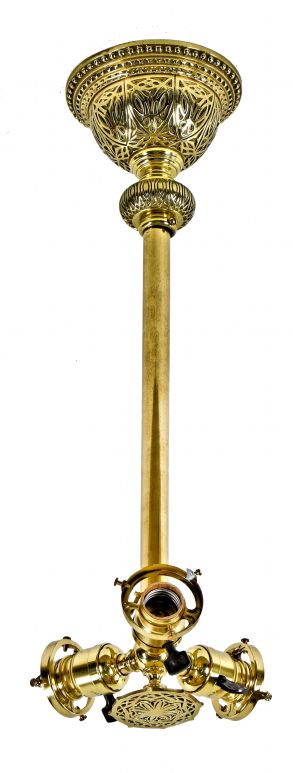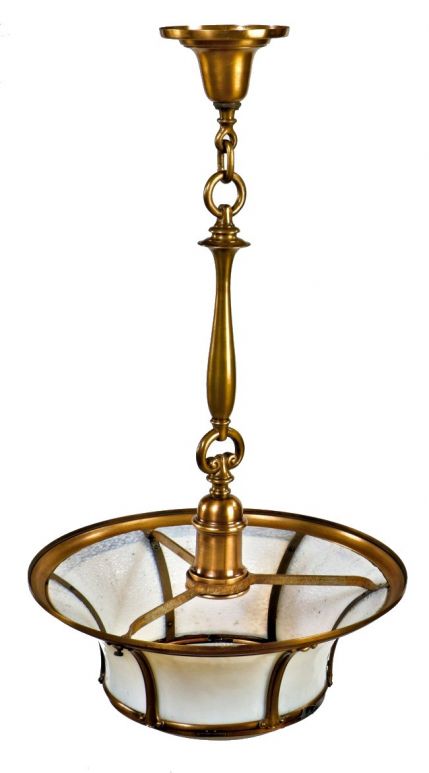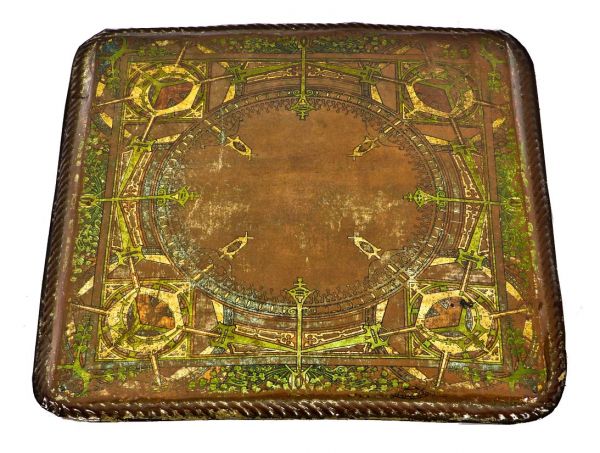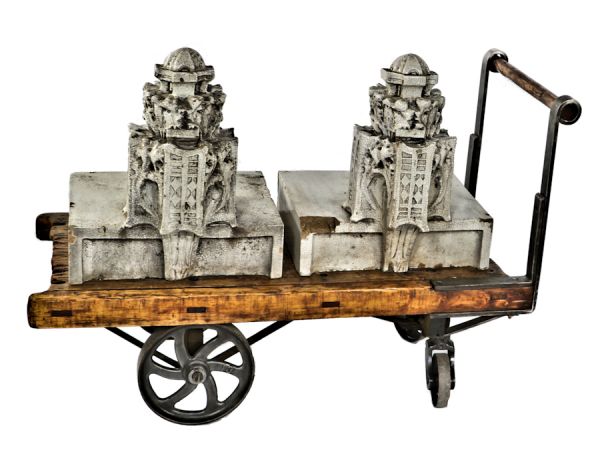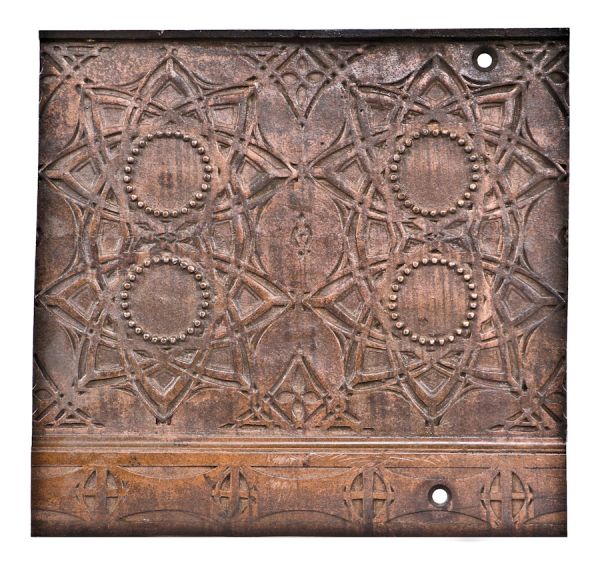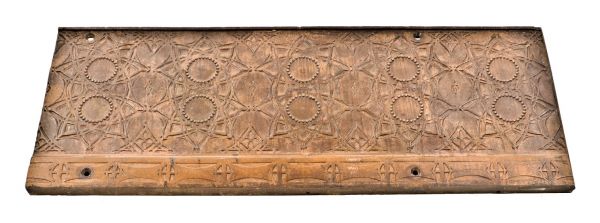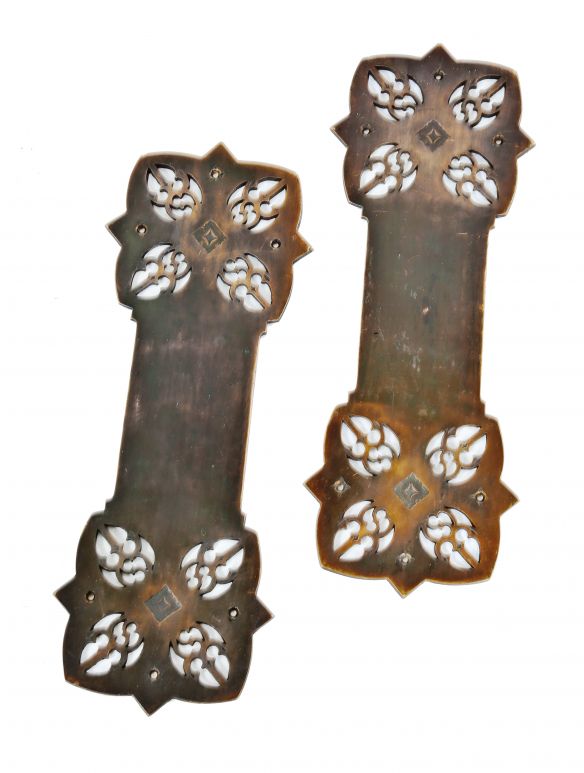historically important early 20th century black enameled wrought iron downtown chicago marshall field exterior building sign bracket
SOLD
Out of stock
SKU
UR-23887-16
possibly winslow brothers foundry, chicago, ills.
very unique and exceptionally rare early 20th century black enameled wrought iron ornament removed from the extant marshall field & co. building. the decorative panel was likely affixed to the building's exterior, with the centrally located rectangular-shaped opening containing a street sign. the neoclassical style symmetrical building element is ornamented with intricate leafage, scrollwork and geometric shapes. attributed to the winslow brothers company, chicago, il. marshall field and company, built in 1891-1892, was the flagship location of the marshall field and company, also known as marshall field's chain of department stores. the building is located in the chicago "loop" area of the downtown central business district in cook county, illinois, u.s.a., and it takes up the entire city blockbounded clockwise from the west by north state street, east randolph street, north wabash avenue, and east washington street. marshall field's established numerous important business "firsts" in this building and in a long series of previous elaborate decorative structures on this site for the last century and a half, and it is regarded as one of the three most influential establishments in the nationwide development of the department store and in the commercial business economic history of the united states. the building, which is the second largest store in the world, was both declared a national historic landmark and listed on the national register of historic places on june 2, 1978, and it was designated a chicago landmark on november 1, 2005. the building architecture is known for its multiple atria (several balconied atrium - "great hall") and for having been built in stages over the course of more than two decades. its ornamentation includes a louis comfort tiffany, (1848-1933), (later tiffany & co. studios of new york city) mosaic vaulted ceiling and a pair of well-known outdoor street-corner clocks at state and washington, and later at state and randolph streets, which serve as symbols of the store since 1897. although the official corporate name of the retail entity based in this building had been marshall field & company (nicknamed marshall field's) from 1881 until 2006, the store has had five different names since its inception in 1852 as p. palmer & co. in 1868, after bowing out of involvement in day-to-day operations with his new partners of field, palmer & leiter, potter palmer convinced marshall field and levi leiter to move the field, leiter & co. store to a building palmer owned on state street at the corner of washington street. after being consumed by the "great chicago fire" and splitting the wholesale business from the retail operations, the store resumed operations at state and washington in a rebuilt structure, now leased from the singer sewing machine company. in 1877 another fire consumed this building, and when a new singer building was built to replace it at the same location in 1879, field then put together the financing to purchase it. the business has remained there ever since, and it has added four subsequent buildings to form the integrated structure that is now called the "marshall field and company building". chicago's retailing center was state street in the famous downtown "loop" after the "great chicago fire" of 1871, and this center has been anchored by marshall field's and its predecessor companies in this building complex. however, commuter suburbs began to have significant retail districts by the 1920's. in the 1920's, the store created new suburban locations such as marshall field and company store to remain competitive. after 1950, with the booming post-world war ii economic/social climate with increasing suburban residential and commercial development, saw the construction of first "strip" shopping centers, followed by regional enclosed shopping malls along major thoroughfares and interstate highways such as the "magnificent mile" reduced the role of the "loop"'s daily significance to many chicagoans as downtown retail sales slipped and gradually additional business moved outward following first the streetcar lines and then the automobile. eventually, there was an influx of stores from other parts of the country as the pace of commercial retailing merged, consolidating, and spreading first regionally then nationwide. nonetheless, the marshall field and company building has survived at this location. marshall field took over the operations of the store in 1881 and became the first merchant to post the price of the goods in plain sight, which eliminated the common practice of haggling and charging whatever the buyer would pay. on top of that, field stood behind his product with his famous slogan that symbolized his willingness to refund the full price of all merchandise (a policy inherited from early mentor and partner potter palmer) purchased in his store: the 12-story granite building was constructed in stages between 1891-1892 and 1914 on a partitioned block with sections that were added to the building in 1902, 1906, 1907, and 1914. although he died before they were constructed, charles b. atwood, (1849-1895), of the d. h. burnham & company (from original 1891-1892 structure's architect daniel h. burnham, (1846-1912), later firm), designed the two primary additional sections along state street (the north building built in 1902 and the south in 1907). for a time, the building was the largest store in the world at 73 acres of floorspace, with the largest book, china, shoe, and toy departments of all the world's department stores. the current building has several atria: a louis comfort tiffany, (1848-1933), (later tiffany & co. studios of new york city) mosaic vaulted ceiling dome caps a 5-story balconied atrium in the southwest corner; the northwest section has a 13-story skylit atrium, and a newer atrium with a fountain in the center is bridged by double escalator banks. the tiffany ceiling is over 6,000 square feet, and it is the first iridescent glass dome and it continues to be the largest glass mosaic of its kind. only egypt's 3,000-year-old temple of karnak, with its 70-foot columns rivals the four 50-foot (15 m) ionic-style capped granite columns on the state street façade. the building is known for its two exterior clocks, which weigh about 7.5 short tons each, on its northwest and southwest corners along state street at both randolph and washington streets. the southwest clock at the original washington street intersection, known as ---"the great clock", was installed on november 26, 1897. marshall field envisioned the clock as a beacon for his store which he viewed as a meeting place. the clock was installed after the southwest corner of the store had become a popular meeting place and people began leaving notes for one another on the marshall field's windows. the clock was an attempt to end this practice, and encourage punctuality. measures 79 x 33 inches.
You Might Also Like
WORDLWIDE SHIPPING
If required, please contact an Urban Remains sales associate.
NEW PRODUCTS DAILY
Check back daily as we are constantly adding new products.
PREMIUM SUPPORT
We're here to help answer any question. Contact us anytime!
SALES & PROMOTIONS
Join our newsletter to get the latest information

